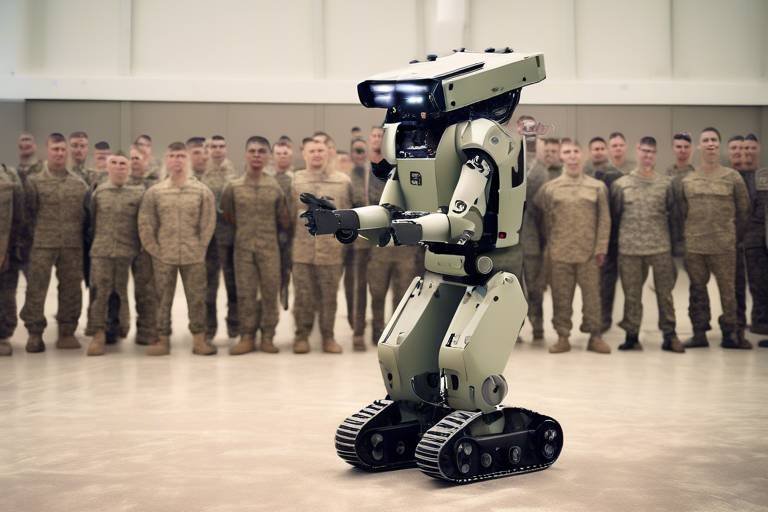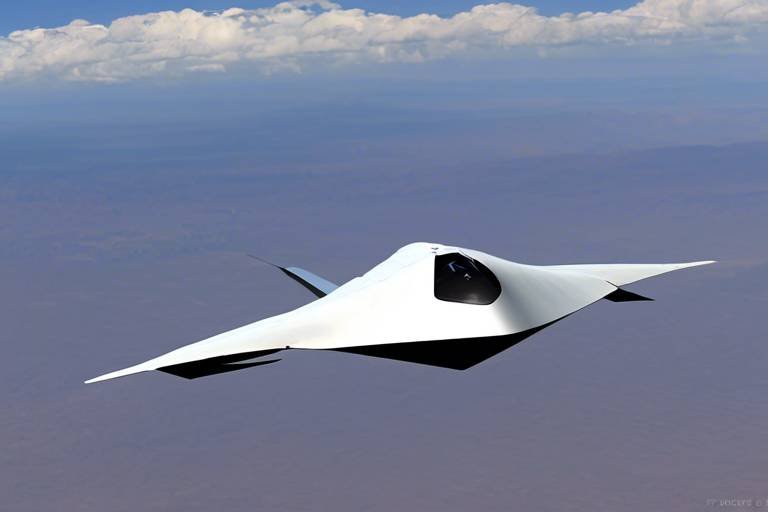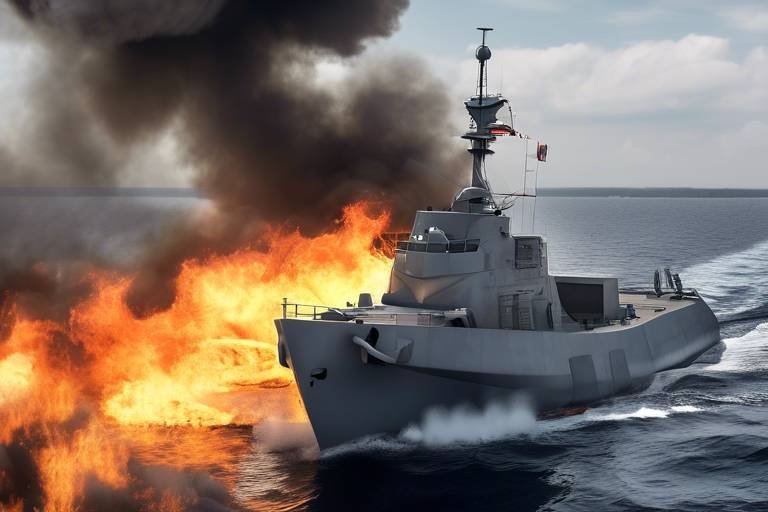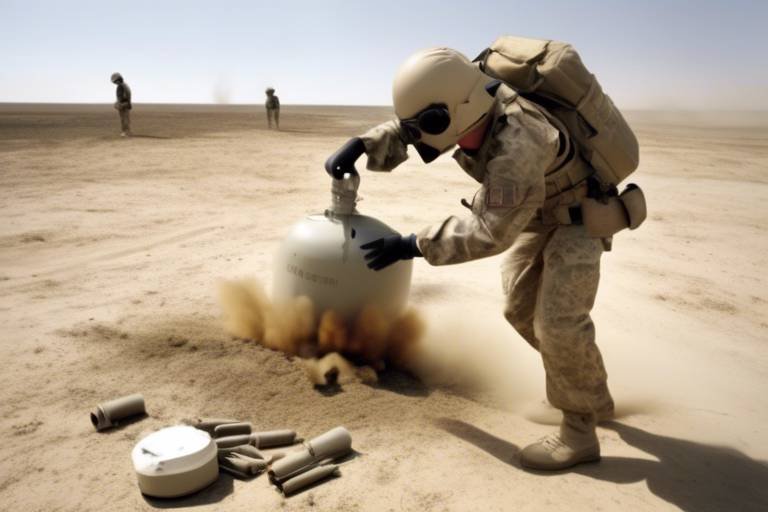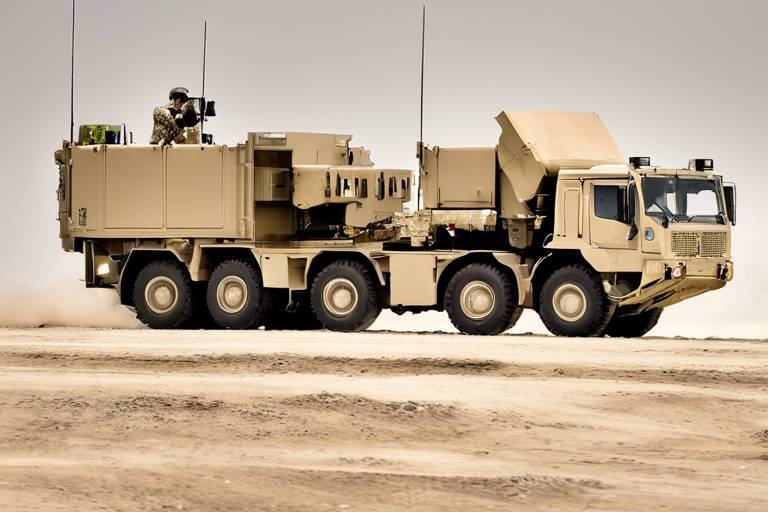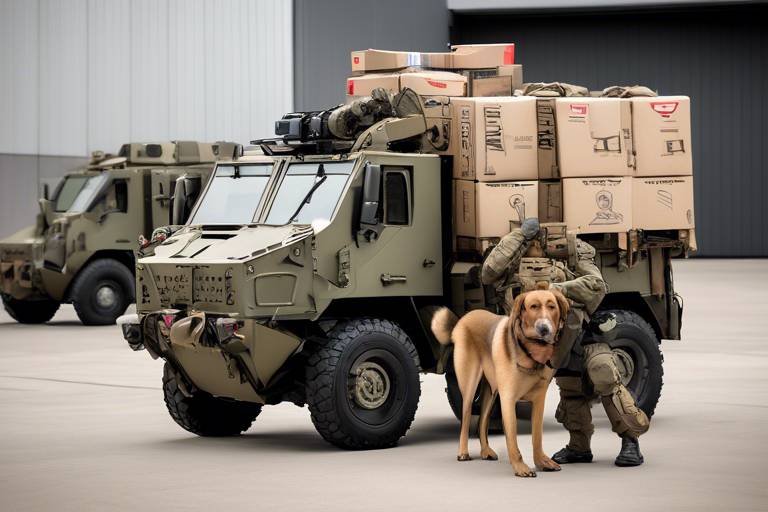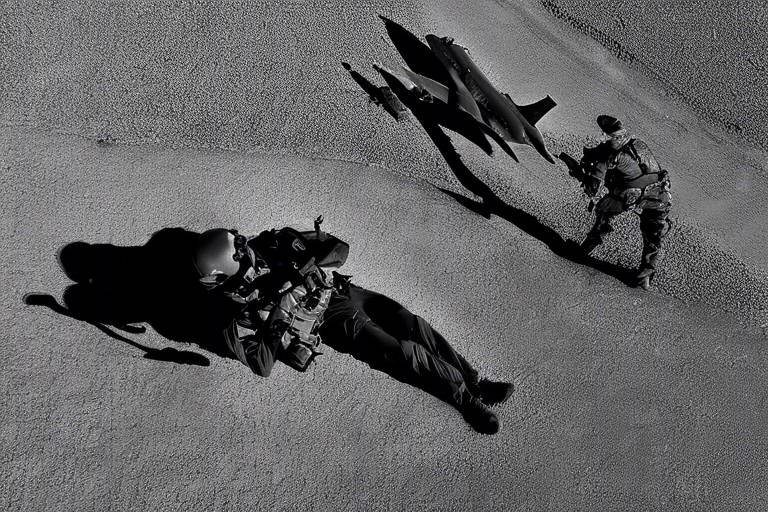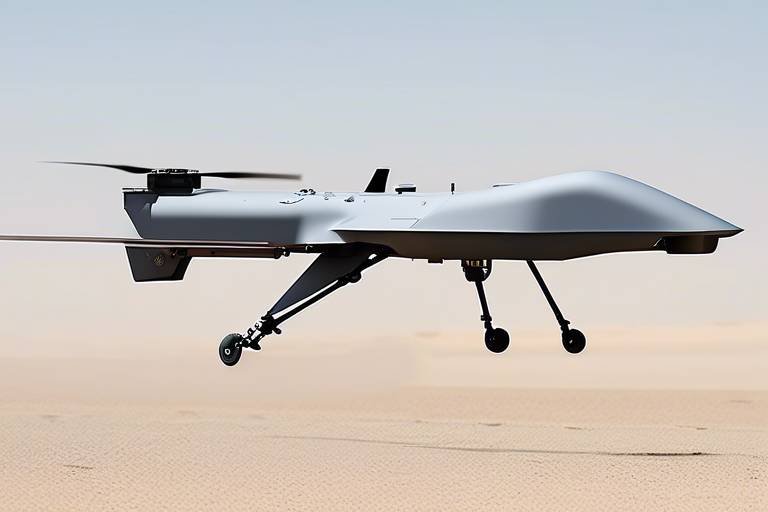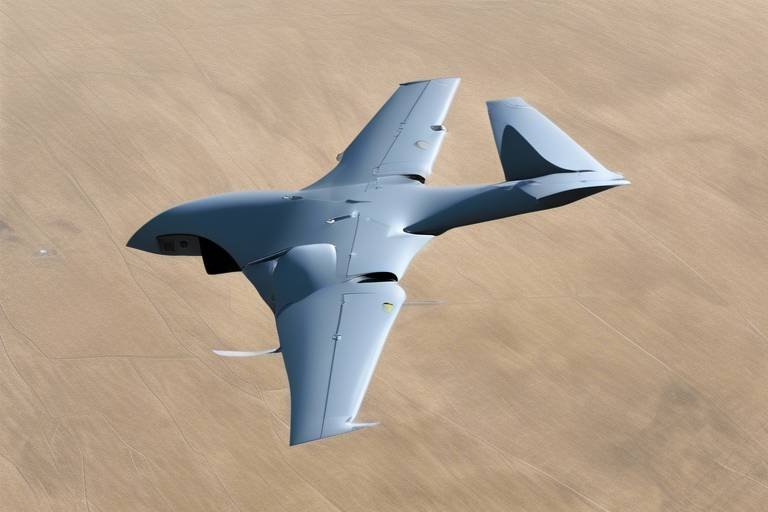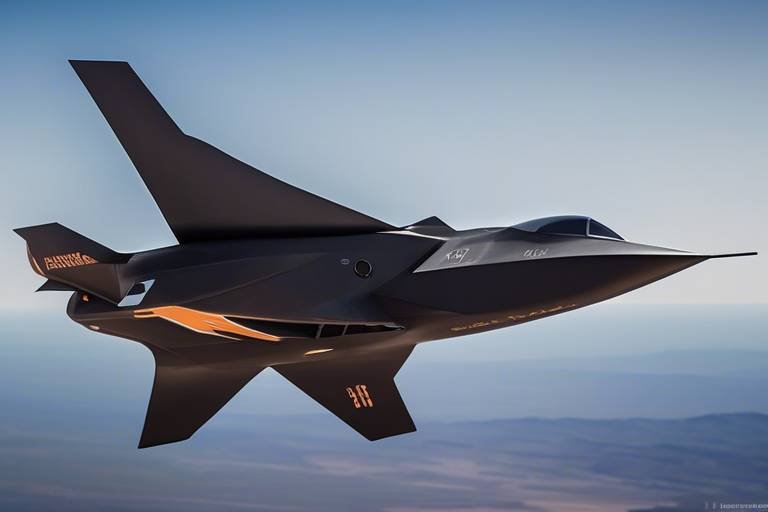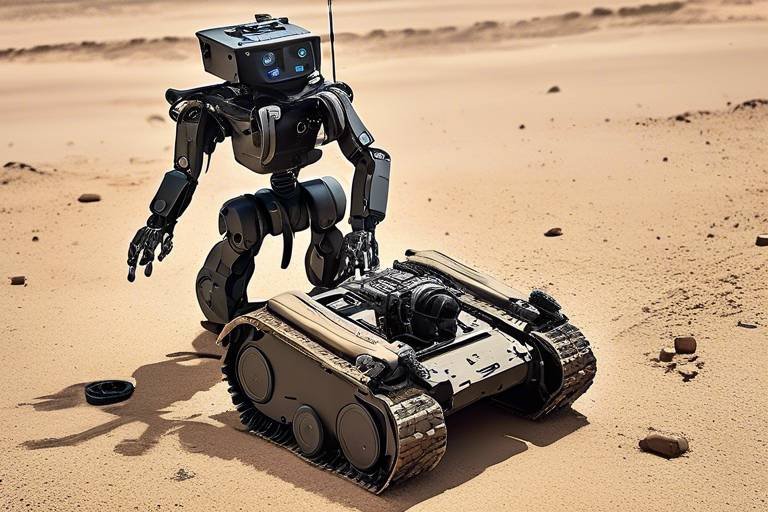Current Applications of the MAARS Robot in Military Training
The Modular Advanced Armed Robotic System, or MAARS, is revolutionizing the way military training is conducted. With its advanced technological features and versatility, MAARS is not just a tool; it's a game-changer in preparing soldiers for the complexities of modern warfare. Imagine a training environment where soldiers can engage in realistic combat scenarios without the associated risks. That’s exactly what MAARS offers. Its ability to simulate various combat situations allows troops to hone their skills, make critical decisions, and ultimately become more effective in real-world operations.
One of the standout features of MAARS is its modular design, which allows for customization based on mission requirements. This adaptability enables it to perform a variety of functions, from reconnaissance to direct engagement. The integration of robotics into military training signifies a shift towards more innovative and effective methodologies. As we delve deeper into the applications of MAARS, it becomes evident that this technology not only enhances training but also aligns with the evolving landscape of military tactics.
Understanding the MAARS robot's design and technological advancements provides insight into its operational capabilities and effectiveness in military training environments. The MAARS robot is equipped with cutting-edge sensors, cameras, and communication systems that allow it to operate autonomously or under human control. This flexibility means it can adapt to various training scenarios, whether in urban settings or open fields. Additionally, the robot's ability to gather real-time data and feedback during training exercises is invaluable for both instructors and trainees, offering a comprehensive learning experience.
MAARS is employed in various training scenarios, simulating real combat situations to enhance soldiers' skills and decision-making processes. The robot can navigate complex environments, making it an ideal candidate for urban warfare simulations. These scenarios are crucial for preparing soldiers to face the challenges of modern combat, where urban landscapes often serve as battlegrounds. By incorporating MAARS into these training exercises, military personnel can practice tactical maneuvers and improve their situational awareness in a controlled yet realistic setting.
In urban warfare training, MAARS assists in teaching troops how to navigate complex environments, improving their tactical responses and situational awareness. The robot can traverse through buildings, alleys, and various terrains, providing soldiers with a safe yet challenging training ground. This not only helps in familiarizing troops with the layout of urban environments but also enhances their ability to respond to threats in real-time.
The robot's ability to conduct building clearances reduces risks to personnel, allowing for safer and more efficient training exercises. MAARS can enter buildings first, gathering intelligence and identifying threats without putting soldiers in harm's way. This capability is particularly beneficial in training scenarios focused on close-quarters combat, where the stakes are incredibly high. With MAARS leading the charge, troops can practice their tactics with greater confidence and safety.
MAARS can simulate hostage scenarios, providing soldiers with realistic experiences that prepare them for high-stakes rescue operations. In these drills, the robot can act as both a surveillance tool and a means of distraction, allowing soldiers to strategize and execute their plans effectively. The realism of these simulations is crucial for building the skills necessary to respond to actual hostage situations, where every second counts and decisions must be made swiftly.
MAARS also plays a critical role in logistical support, helping transport supplies and equipment during training exercises. This not only streamlines operations but also allows soldiers to focus on their training without the added burden of logistics. The robot can carry heavy loads over challenging terrain, ensuring that troops have the resources they need without compromising their training time. This integration of MAARS into logistical operations reflects a broader trend in military training, where technology is leveraged to enhance efficiency and effectiveness.
The integration of MAARS into military training offers numerous benefits, including increased safety, enhanced learning experiences, and improved resource management. By utilizing robots like MAARS, military personnel face reduced exposure to danger during training exercises, allowing for safer operations. The risk reduction is significant, as soldiers can practice high-risk scenarios without the fear of injury or loss of life.
Implementing MAARS can lead to significant cost savings in training programs by minimizing the need for live resources and personnel. The ability to conduct realistic simulations without the logistical challenges of live training exercises means that military budgets can be allocated more efficiently. This cost-effectiveness is essential in an era where military funding is often scrutinized, making MAARS not just a tactical asset but a financial one as well.
Exploring the future developments of MAARS technology can illuminate potential enhancements and expanded roles within military training frameworks. Emerging technologies may further enhance MAARS capabilities, making it an even more valuable asset in military training scenarios. Innovations in AI and machine learning could enable MAARS to adapt and learn from training experiences, providing even more tailored training solutions for soldiers.
Future applications may see MAARS integrated with other training systems, creating a more comprehensive and effective training environment for soldiers. Imagine a scenario where MAARS works in conjunction with virtual reality systems, providing an immersive training experience that combines the physical and digital worlds. This synergy could transform military training, making it more engaging and effective than ever before.
- What is MAARS? - MAARS stands for Modular Advanced Armed Robotic System, a robotic platform used in military training.
- How does MAARS enhance military training? - By simulating realistic combat scenarios, MAARS helps soldiers develop critical skills and decision-making abilities.
- Is MAARS safe for soldiers? - Yes, MAARS reduces the risk of injury by allowing troops to practice in high-risk situations without direct exposure to danger.
- What are the future prospects for MAARS? - Future advancements may include better AI integration and collaboration with other training systems to enhance training efficacy.

Introduction to MAARS Technology
The Modular Advanced Armed Robotic System (MAARS) represents a significant leap in military technology, blending advanced robotics with military strategy to enhance training and operational effectiveness. Designed with modularity in mind, MAARS is not just a single-purpose robot; it can be configured for various roles, making it an adaptable tool in the ever-evolving landscape of warfare. This flexibility allows military trainers to customize the robot for specific scenarios, ensuring that soldiers receive the most relevant and impactful training possible.
One of the most impressive aspects of MAARS technology is its ability to simulate real-world combat situations. Equipped with a range of sensors and cameras, MAARS can gather and relay information about its surroundings in real-time. This feature enhances situational awareness for troops, as they can learn to make decisions based on the data provided by the robot. Imagine having a robotic partner that can scout ahead, identify potential threats, and relay that information back to you—this is the kind of cutting-edge support MAARS provides.
Furthermore, the technology behind MAARS incorporates artificial intelligence (AI) and machine learning capabilities, allowing the robot to adapt to different environments and scenarios autonomously. As soldiers train with MAARS, they are not just practicing tactics; they are also learning how to interact with and leverage advanced technologies that they may encounter in real combat situations. This prepares them for a future where technology plays an integral role on the battlefield.
In summary, the introduction of MAARS technology into military training is a game-changer. It enhances learning experiences, reduces risks, and prepares soldiers for the complexities of modern warfare. As military training evolves, the integration of such advanced systems will likely become the norm rather than the exception, paving the way for a new era of military readiness.

Training Scenarios Utilizing MAARS
The Modular Advanced Armed Robotic System (MAARS) is revolutionizing military training by providing a platform that simulates real combat scenarios. Its ability to replicate various environments and situations allows soldiers to hone their skills in a controlled yet realistic setting. Imagine being able to practice life-and-death decisions without the inherent risks of actual combat. That's exactly what MAARS offers, making it an invaluable tool in modern military training.
One of the most exciting aspects of MAARS is its versatility in training scenarios. Whether it's urban warfare, hostage rescue operations, or logistical support, MAARS can adapt to meet the specific needs of military training. For instance, in urban warfare simulations, MAARS can navigate complex building layouts, providing soldiers with the opportunity to practice tactics that are crucial in real-world situations. This not only enhances their tactical responses but also improves their situational awareness, which is essential for survival on the battlefield.
In urban warfare training, MAARS serves as a lifelike adversary or ally, helping soldiers develop strategies for navigating tight spaces and crowded environments. The robot's advanced sensors and mobility allow it to traverse obstacles, making it an excellent stand-in for various scenarios that troops might encounter in an urban setting. This is particularly important as urban areas are often the battlegrounds of modern conflicts, where the stakes are high and the margin for error is slim.
One of the critical aspects of urban warfare is building clearing operations. MAARS excels in this area by taking on the dangerous task of entering potentially hostile environments first. By sending in the robot, military personnel can assess the situation without putting themselves in immediate danger. This not only enhances safety but also facilitates more efficient training exercises, allowing soldiers to focus on strategy rather than worrying about their physical safety.
Another vital application of MAARS is in hostage rescue drills. Imagine a scenario where time is of the essence, and every second counts. MAARS can simulate hostage situations, allowing soldiers to practice their response strategies in a realistic environment. The robot can be programmed to replicate various hostage scenarios, providing soldiers with the experience they need to react quickly and effectively in high-stakes situations. This level of preparation can make a significant difference in real-life operations.
Beyond combat scenarios, MAARS also plays a crucial role in logistical support during training exercises. Think of it as a robotic supply runner, capable of transporting equipment and supplies across challenging terrains. This not only saves time but also frees up personnel to focus on more critical tasks. By integrating MAARS into logistics, military training programs can operate more efficiently, ensuring that soldiers have what they need when they need it.
In summary, the training scenarios utilizing MAARS are as diverse as they are impactful. From urban warfare simulations to logistical support, this advanced robot is changing the way military personnel prepare for real-world challenges. The integration of MAARS into training programs not only enhances the learning experience but also significantly reduces risks and improves overall effectiveness. As military strategies evolve, so too will the applications of MAARS, paving the way for a new era in military training.
- What is MAARS? - MAARS stands for Modular Advanced Armed Robotic System, designed to assist in military training by simulating real combat scenarios.
- How does MAARS improve training safety? - By allowing soldiers to practice in realistic environments without the risks associated with live combat, MAARS significantly reduces exposure to danger.
- Can MAARS be used in various training scenarios? - Yes, MAARS is versatile and can be employed in urban warfare, hostage rescue drills, and logistical support, among others.
- What are the benefits of using MAARS in military training? - The integration of MAARS leads to increased safety, enhanced learning experiences, and cost-effectiveness in training programs.

Urban Warfare Simulations
The landscape of modern warfare is constantly evolving, and with it, the need for effective training methods has never been more crucial. using the MAARS robot are revolutionizing how military personnel prepare for real-world combat scenarios. Imagine a bustling city street, filled with the sounds of chaos and confusion, where every corner could hide a potential threat. In such environments, soldiers must be equipped not only with physical skills but also with the mental acuity to make split-second decisions. This is where the MAARS robot shines.
One of the primary advantages of using MAARS in urban warfare training is its ability to navigate complex environments that mimic real-life urban settings. The robot is designed to traverse narrow alleys, climb stairs, and even enter buildings, providing a versatile training partner for soldiers. This capability allows troops to practice essential skills such as tactical movement, team coordination, and situation assessment without putting themselves in harm's way. By integrating MAARS into their training exercises, soldiers can experience a realistic combat environment while significantly reducing the risks associated with live training.
Moreover, the MAARS robot can be equipped with various sensors and cameras, enabling it to gather real-time intelligence. This feature is invaluable during training, as it allows soldiers to understand how to gather information from their surroundings effectively. Real-time feedback from the MAARS can enhance the learning experience, helping troops adjust their strategies and improve their overall performance. For instance, after a training exercise, instructors can review the data collected by MAARS to identify strengths and weaknesses in the soldiers' approaches, fostering a culture of continuous improvement.
In addition to its navigational capabilities, MAARS is also instrumental in conducting building clearing operations. This critical aspect of urban warfare requires precision and teamwork, and MAARS can take the lead in assessing threats within buildings before personnel enter. By using the robot to scout ahead, soldiers can minimize their exposure to danger, making the training process not only safer but also more efficient. Imagine a scenario where MAARS enters a building first, transmitting live video feeds back to the team outside, allowing them to make informed decisions about their next steps. This kind of technology is not just a luxury; it is becoming a necessity in modern military training.
Furthermore, MAARS can simulate hostage rescue drills, providing soldiers with realistic scenarios that prepare them for high-stakes operations. These simulations are critical for developing the skills necessary to handle sensitive situations where lives are at stake. The robot can create various situations, from negotiating with a hostage-taker to executing a tactical rescue, all while ensuring that soldiers can practice their responses in a controlled environment. This not only enhances their tactical skills but also builds their confidence in handling real-life crises.
As we look to the future, the integration of MAARS in urban warfare simulations promises to enhance military training further. The ability to create dynamic and unpredictable scenarios will prepare soldiers for the complexities of modern combat. With continuous advancements in technology, we can expect MAARS to become even more sophisticated, incorporating artificial intelligence and machine learning to adapt to new challenges. The future of military training is not just about physical prowess; it's about leveraging technology to create smarter, more effective soldiers.
- What is the MAARS robot?
MAARS stands for Modular Advanced Armed Robotic System, and it is designed to assist military personnel in various training scenarios by providing a safe, effective, and realistic training environment.
- How does MAARS enhance urban warfare training?
MAARS enhances training by simulating real combat scenarios, navigating complex urban environments, and providing real-time intelligence, which helps soldiers make informed decisions.
- Can MAARS be used for building clearing operations?
Yes, MAARS is specifically designed to assist in building clearing operations, allowing it to scout ahead and assess threats before soldiers enter potentially dangerous areas.
- What are the benefits of using robots in military training?
Using robots like MAARS in military training reduces risks to personnel, enhances learning experiences, and can lead to significant cost savings by minimizing the need for live resources.

Building Clearing Operations
The concept of is a critical aspect of modern military training, and the MAARS robot is revolutionizing how these operations are conducted. Traditionally, these exercises involve high risks for personnel, as soldiers must navigate potentially hostile environments filled with unknown threats. However, with the introduction of the MAARS robot, the dynamics of these operations are changing dramatically.
Imagine a scenario where soldiers are tasked with clearing a multi-story building that could harbor enemy combatants. Instead of sending troops in first, commanders can deploy the MAARS robot to assess the situation. Equipped with advanced sensors and cameras, MAARS can gather real-time intelligence, providing a detailed overview of the building's layout and any potential threats. This initial reconnaissance reduces the element of surprise that could endanger soldiers' lives.
One of the standout features of MAARS during building clearing operations is its ability to operate in confined spaces. Its compact design allows it to maneuver through narrow hallways and tight corners, which are often the most dangerous areas in any tactical scenario. By sending MAARS ahead, troops can maintain a safer distance while still gathering crucial information. This not only enhances the safety of the personnel but also increases the efficiency of the operation.
Furthermore, MAARS is equipped with various tools that allow it to perform tasks such as opening doors, disabling traps, and even engaging targets if necessary. This functionality transforms it from a mere reconnaissance tool into an active participant in the clearing operation. For instance, if MAARS identifies a hostile presence, it can relay that information back to the command center while simultaneously taking action to neutralize the threat, all without putting soldiers in harm's way.
In addition to its technological prowess, the use of MAARS in building clearing operations also fosters a better learning environment for soldiers. Trainees can engage in realistic simulations where they practice their tactical skills without the immediate dangers associated with live exercises. This hands-on experience with MAARS not only builds confidence but also enhances their decision-making skills under pressure.
As we look to the future, the integration of MAARS into building clearing operations is expected to evolve further. With advancements in AI and machine learning, future iterations of MAARS may be able to autonomously navigate complex environments and make real-time tactical decisions. This could lead to a paradigm shift in military training, where robots play an even more significant role in ensuring the safety and effectiveness of soldiers during critical operations.
- What is MAARS? MAARS stands for Modular Advanced Armed Robotic System, a versatile robot used in military training and operations.
- How does MAARS improve safety in building clearing operations? By conducting reconnaissance and engaging threats, MAARS reduces the need for soldiers to enter potentially dangerous environments first.
- Can MAARS operate in confined spaces? Yes, its compact design allows it to navigate tight areas effectively, making it ideal for building clearing tasks.
- What are the future prospects for MAARS technology? Future developments may include enhanced AI capabilities, enabling MAARS to make autonomous decisions in complex scenarios.

Hostage Rescue Drills
Hostage rescue drills are among the most intense and critical training scenarios faced by military personnel. The stakes are incredibly high, and the pressure is palpable. In these drills, the Modular Advanced Armed Robotic System (MAARS) steps in as a game-changer. Imagine a robot that can navigate through a building, gather intelligence, and even provide cover for soldiers—all without putting human lives at risk. This is not just science fiction; it's the reality of modern military training.
During hostage rescue drills, MAARS can simulate various environments and situations that soldiers might encounter in real-life operations. These simulations can include everything from urban settings with multiple floors to complex layouts that require strategic thinking and quick decision-making. The robot's ability to assess the environment allows soldiers to plan their approach more effectively. For example, MAARS can be deployed to scout a building before troops enter, providing valuable information about the layout and potential threats. This capability significantly enhances situational awareness and helps in formulating tactical responses.
Furthermore, MAARS can be equipped with advanced sensors and cameras that relay real-time video feeds back to command centers. This information is crucial for making informed decisions during a hostage situation. It's like having a pair of eyes in the room, ensuring that commanders can monitor developments without exposing their personnel to danger. In this way, MAARS acts as both a reconnaissance tool and a tactical partner, allowing soldiers to focus on their mission without the constant fear of ambush or surprise attacks.
One of the most compelling aspects of using MAARS in hostage rescue drills is its ability to create a realistic training experience. Soldiers can practice various scenarios, such as negotiating with captors or executing a breach and clear operation, all while using the robot as a support system. This practice not only builds confidence but also hones their skills in a controlled environment, preparing them for the unpredictable nature of real-world situations.
In addition to enhancing the training experience, the use of MAARS in hostage rescue drills also emphasizes team coordination. Soldiers learn to work alongside the robot, understanding its capabilities and limitations, which fosters a sense of camaraderie between human and machine. This relationship is vital, as it teaches soldiers how to integrate technology into their operations seamlessly. With the increasing reliance on robotics in modern warfare, mastering this integration is essential for future success.
To summarize, the incorporation of MAARS in hostage rescue drills not only elevates the training experience but also significantly improves operational readiness. By reducing risks, enhancing situational awareness, and fostering teamwork, MAARS is redefining how military personnel prepare for some of the most challenging scenarios they may face. As technology continues to evolve, we can only anticipate even more innovative applications of robots like MAARS in military training.
- What is the MAARS robot?
MAARS stands for Modular Advanced Armed Robotic System, designed to assist military personnel in various training and combat scenarios. - How does MAARS enhance hostage rescue drills?
MAARS provides real-time reconnaissance, reduces risks, and allows soldiers to practice realistic scenarios without exposing themselves to danger. - Can MAARS be used in other training scenarios?
Yes, MAARS is versatile and can be employed in various training environments, including urban warfare simulations and logistical support. - What are the future prospects for MAARS technology?
Future developments may include enhanced capabilities and better integration with other training systems, making it an even more valuable asset.

Field Support and Logistics
The role of the Modular Advanced Armed Robotic System (MAARS) extends far beyond just combat simulations; it is a vital asset in the realm of . Imagine a scenario where troops are deployed in a challenging environment, surrounded by unpredictable conditions. This is where MAARS shines, acting as a reliable partner that enhances operational efficiency and effectiveness. With its robust design and advanced technology, MAARS can transport supplies, equipment, and even perform reconnaissance missions, which significantly alleviates the logistical burdens on soldiers.
One of the most remarkable features of MAARS is its ability to navigate through various terrains, whether it’s rocky landscapes, urban jungles, or dense forests. This adaptability allows military units to maintain a steady flow of essential resources without risking personnel in potentially dangerous situations. For instance, when troops are engaged in training exercises that mimic real-world scenarios, MAARS can be deployed to deliver critical supplies such as ammunition, medical kits, and food rations. This not only ensures that soldiers have what they need to succeed but also allows them to focus on honing their skills without the distraction of logistics.
Additionally, the operational efficiency of MAARS in logistics is evident through its autonomous capabilities. The robot can be programmed to follow specific routes, monitor its surroundings, and respond to changes in the environment, making it an invaluable tool for transporting materials in unpredictable settings. To illustrate its effectiveness, consider the following table that outlines some key logistical functions of MAARS:
| Function | Description |
|---|---|
| Supply Transport | Delivers essential supplies and equipment to troops in the field. |
| Reconnaissance | Scouts areas ahead of troops to identify threats and obstacles. |
| Emergency Response | Delivers medical supplies and assists in casualty evacuation. |
Moreover, the integration of MAARS in logistical operations can lead to significant cost savings for military training programs. By reducing the need for multiple personnel to transport supplies, the military can allocate resources more efficiently, allowing for better training outcomes. This is particularly important in exercises that require rapid deployment and response, where every second counts.
In conclusion, the MAARS robot is not just a tool for combat training; it is a game-changer in the field of logistics. By enhancing the efficiency of supply transport and enabling safer operations, MAARS allows military personnel to focus on what truly matters: training effectively and preparing for the challenges they may face in real combat situations. As military technology continues to evolve, the potential for MAARS to play an even greater role in logistics is immense, paving the way for a more streamlined and effective military training framework.
- What is the MAARS robot? The Modular Advanced Armed Robotic System (MAARS) is a versatile robotic platform designed for military applications, including training and logistics.
- How does MAARS enhance training exercises? MAARS simulates real combat scenarios, allowing soldiers to practice their skills in a safe and controlled environment.
- Can MAARS operate autonomously? Yes, MAARS is equipped with advanced navigation systems that allow it to operate autonomously and respond to its environment.
- What are the cost benefits of using MAARS? By reducing the need for personnel in logistics roles, MAARS can lead to significant cost savings in military training programs.

Advantages of Using MAARS in Training
The integration of the Modular Advanced Armed Robotic System (MAARS) into military training environments is a game-changer. This innovative technology not only enhances the overall training experience but also brings a plethora of advantages that are hard to ignore. One of the most significant benefits is the increased safety it offers to military personnel. Traditional training exercises often expose soldiers to various risks, especially in high-stakes scenarios. However, by deploying MAARS, the danger level is significantly reduced, allowing troops to focus on honing their skills without the constant worry of physical harm.
Moreover, MAARS is designed to operate in complex and unpredictable environments, which mirrors the conditions soldiers might face in real combat situations. This capability enhances the learning experience by providing realistic simulations that challenge soldiers to think critically and adapt quickly. Imagine being able to practice urban warfare tactics without the fear of injury or the need for extensive resources. This is precisely what MAARS brings to the table, allowing for repeated practice without the associated risks.
Another key advantage is the cost-effectiveness of using MAARS in training programs. Military budgets are often tight, and every dollar counts. By utilizing robotic systems like MAARS, the need for live resources—such as ammunition and personnel—can be minimized. This not only saves money but also allows for more frequent training sessions. Consider this: a single MAARS unit can replace multiple training scenarios that would otherwise require extensive logistical support, making it a smart investment for military organizations.
Furthermore, MAARS can be programmed for various training scenarios, making it an incredibly versatile addition to military training frameworks. From urban warfare simulations to logistical support, the robot is capable of adapting to different roles as needed. This adaptability ensures that soldiers receive comprehensive training that prepares them for a wide range of situations they may encounter in the field.
In addition to all these advantages, the use of MAARS in training fosters a culture of innovation and technological advancement within military ranks. Soldiers become accustomed to working alongside advanced technologies, which can enhance their overall operational effectiveness. This exposure to robotics and automation not only prepares them for current battlefield scenarios but also equips them with the skills needed for future military engagements where technology will play an even more critical role.
- What is MAARS?
MAARS stands for Modular Advanced Armed Robotic System, a robotic platform designed for military training and operations. - How does MAARS enhance safety during training?
By using MAARS, military personnel can engage in realistic training scenarios without the risk of physical harm, as the robot can perform dangerous tasks. - Is MAARS cost-effective?
Yes, using MAARS can lead to significant cost savings by reducing the need for live resources and allowing for more frequent training exercises. - Can MAARS be used in multiple training scenarios?
Absolutely! MAARS is highly adaptable and can be programmed for various training environments, from urban warfare to logistical support. - What future advancements can we expect from MAARS?
With ongoing technological advancements, MAARS is expected to become even more capable and integrated with other training systems in the future.

Risk Reduction for Personnel
When it comes to military training, safety is paramount. The integration of the MAARS robot into training exercises has significantly transformed how military personnel approach risk management. By utilizing MAARS, soldiers can engage in realistic combat scenarios without the inherent dangers that come with live training. Imagine being able to simulate a high-stakes operation while minimizing the chance of injury—this is exactly what MAARS offers. The robot can take on the most dangerous roles, allowing human soldiers to observe and learn from a safe distance.
One of the most compelling advantages of using MAARS is its ability to conduct reconnaissance and gather intelligence in hostile environments. Instead of sending soldiers into potentially lethal situations, the MAARS robot can be deployed to assess threats and gather crucial information. This not only keeps personnel safe but also enhances the quality of training by providing real-time data that can be analyzed post-exercise.
Additionally, the MAARS robot can be programmed to mimic various enemy tactics, allowing soldiers to practice their responses without the risk of actual combat. For instance, during a simulated ambush, MAARS can act as the "enemy," forcing troops to adapt and react as they would in a real-life scenario. This kind of training not only prepares soldiers for the unpredictability of warfare but also drastically reduces their exposure to danger.
Moreover, the use of MAARS in training exercises leads to a more controlled environment. In traditional training, unexpected variables can lead to accidents or injuries. However, with a robot like MAARS, the conditions can be managed more effectively. Training scenarios can be designed with specific parameters, ensuring that personnel are not placed in harm's way unnecessarily. This level of control is invaluable in preparing soldiers for the chaos of real combat while keeping them safe.
In summary, the risk reduction provided by the MAARS robot represents a significant leap forward in military training. By allowing soldiers to engage in realistic scenarios without the associated dangers, MAARS not only enhances the training experience but also ensures that personnel come home safe. The future of military training is undoubtedly moving towards a more automated and safer approach, with MAARS leading the charge.
- What is the MAARS robot? The Modular Advanced Armed Robotic System (MAARS) is a versatile robotic platform designed to assist military personnel in various training and operational scenarios.
- How does MAARS improve safety during training? MAARS can perform high-risk tasks, such as reconnaissance and simulation of enemy tactics, thereby reducing the exposure of soldiers to dangerous situations.
- Can MAARS be used in real combat situations? While MAARS is primarily designed for training, its capabilities may also be adapted for real combat scenarios, enhancing operational effectiveness.
- What are the future prospects for MAARS technology? Future advancements may include improved AI capabilities, integration with other military systems, and enhanced functionalities for a wider range of training applications.

Cost-Effectiveness in Training
When it comes to military training, the cost-effectiveness of utilizing advanced technology like the MAARS robot cannot be overstated. Traditional training methods can be incredibly resource-intensive, requiring extensive manpower, equipment, and sometimes even live ammunition. However, integrating MAARS into training programs dramatically reduces these costs while enhancing the overall training experience. Imagine a scenario where a single robot can replace dozens of personnel in specific training exercises—this not only saves money but also minimizes the wear and tear on physical resources.
One of the primary ways MAARS achieves this is through its ability to conduct repetitive training exercises without the need for constant human involvement. For instance, in live-fire training scenarios, the MAARS robot can act as a target or even simulate enemy combatants. This allows soldiers to practice their skills without the logistical nightmare of coordinating a large group of trainers and participants. Not to mention, the costs associated with ammunition and other consumables can skyrocket during traditional training sessions.
Moreover, the MAARS robot can be deployed in various environments, making it a versatile tool for different training exercises. Whether it's conducting urban warfare simulations or assisting in logistics, the robot's multifunctionality translates to significant savings. For example, consider the following breakdown of potential cost savings:
| Training Aspect | Traditional Method Cost | MAARS Method Cost | Cost Savings |
|---|---|---|---|
| Ammunition | $10,000 | $1,000 | $9,000 |
| Personnel Costs | $15,000 | $5,000 | $10,000 |
| Logistics | $5,000 | $500 | $4,500 |
| Total | $30,000 | $6,500 | $23,500 |
This table illustrates just how dramatically costs can be reduced when utilizing MAARS in military training. The total savings of $23,500 per training exercise can be reinvested into other areas, such as technology upgrades or additional training resources, ultimately leading to a more prepared and effective military force.
In addition to direct cost savings, the use of MAARS allows for better allocation of resources. Instead of dedicating large numbers of personnel to training exercises, units can focus on more specialized training that requires human oversight. This not only increases the efficiency of training programs but also ensures that soldiers receive the most relevant and effective training possible.
In conclusion, the cost-effectiveness of MAARS in military training is a game-changer. By reducing the financial burden associated with traditional training methods and allowing for more efficient use of resources, the MAARS robot is paving the way for a new era of military preparedness. As we continue to explore its applications, one thing is clear: investing in MAARS is investing in the future of military training.
- What is the MAARS robot?
MAARS stands for Modular Advanced Armed Robotic System, designed to assist in various military training scenarios. - How does MAARS improve cost-effectiveness?
By reducing the need for live resources and personnel, MAARS allows for significant savings in training costs. - Can MAARS be used in different training environments?
Yes, MAARS is versatile and can be deployed in various settings, including urban warfare and logistical support. - What are the safety benefits of using MAARS?
Utilizing MAARS reduces personnel exposure to danger during training exercises, enhancing overall safety.

Future Prospects of MAARS in Military Training
The future of the Modular Advanced Armed Robotic System (MAARS) in military training looks incredibly promising. As technology continues to evolve at a breakneck pace, the capabilities of MAARS are expected to expand significantly. Imagine a world where robots not only assist in training but also adapt in real-time to the dynamic needs of military operations. This is not just a dream; it’s a reality that is quickly approaching. The integration of advanced artificial intelligence (AI) and machine learning algorithms could enable MAARS to analyze training scenarios and provide feedback that is personalized for each soldier, enhancing their learning experience.
Moreover, the potential for collaboration with other advanced technologies is vast. For instance, integrating MAARS with augmented reality (AR) systems can create immersive training environments that simulate real combat situations more accurately than ever before. Soldiers could engage in virtual scenarios where MAARS acts as both a training partner and a realistic adversary, challenging their tactical skills and decision-making abilities in ways that traditional training methods cannot.
Another exciting prospect is the ability of MAARS to operate in swarm formations, where multiple robots work together seamlessly. This could revolutionize how military units train for large-scale operations. Picture a scenario where a team of MAARS robots coordinates to execute complex maneuvers, providing soldiers with a realistic experience of how to manage and respond to multiple threats simultaneously. The implications for enhancing teamwork and communication among soldiers are immense.
In terms of logistical support, future iterations of MAARS may include enhanced capabilities for transporting supplies, equipment, and even injured personnel during training exercises. This not only streamlines operations but also ensures that soldiers can focus on honing their skills without the distraction of logistical challenges. The automation of these tasks can lead to a more efficient training process, ultimately preparing soldiers for the realities of combat.
As we look forward, it’s essential to consider the ethical implications of deploying robots in military training. While the advantages are clear, the integration of advanced technologies must be approached with caution. Ensuring that soldiers maintain essential human skills and judgment in high-pressure situations remains paramount. Balancing the use of robots like MAARS with traditional training methods will be crucial in developing well-rounded military personnel.
In conclusion, the future of MAARS in military training is not just about enhancing capabilities but also about redefining how soldiers prepare for the challenges of modern warfare. With ongoing advancements in technology, the potential for MAARS to transform military training is limitless. As we embrace these innovations, it’s vital to remain focused on the ultimate goal: ensuring our military personnel are equipped with the best tools and training to succeed in their missions.
- What is the MAARS robot?
MAARS stands for Modular Advanced Armed Robotic System, designed to assist in military training by simulating various combat scenarios. - How does MAARS improve military training?
MAARS enhances training by providing realistic simulations, reducing risks to personnel, and allowing for complex tactical exercises. - What are the future developments expected for MAARS?
Future developments may include AI integration, augmented reality capabilities, and swarm robotics for improved training efficiency. - Are there ethical concerns with using robots in military training?
Yes, it’s crucial to maintain a balance between robotic assistance and human skills to ensure soldiers are prepared for real-life decision-making.

Technological Advancements on the Horizon
As we gaze into the future of military training, the Modular Advanced Armed Robotic System (MAARS) is poised to evolve in ways that could revolutionize how soldiers prepare for combat. The integration of cutting-edge technologies is not just a possibility; it’s an impending reality that promises to enhance the operational capabilities of MAARS significantly. Imagine a world where robots are not only reliable but also equipped with advanced artificial intelligence that allows them to learn and adapt in real-time. This could lead to a new era of training where soldiers are better prepared for the unpredictable nature of warfare.
One of the most exciting prospects is the incorporation of machine learning algorithms. These algorithms can analyze vast amounts of data collected during training exercises, identifying patterns and suggesting improvements. For instance, if MAARS is deployed in a simulation that involves urban combat, it can learn from the soldiers' decisions and outcomes, refining its responses for future scenarios. This adaptability could transform MAARS from a simple training tool into a dynamic partner in the field.
Moreover, advancements in sensor technology are set to elevate MAARS' situational awareness. By integrating high-definition cameras, thermal imaging, and even LiDAR systems, MAARS can gather comprehensive data about its surroundings. This wealth of information can be utilized to create more realistic training environments, allowing soldiers to engage in scenarios that closely mimic real-life combat situations. Imagine a training exercise where soldiers are not just reacting to a static environment but are instead faced with a constantly changing battlefield, complete with obstacles and threats that evolve in real-time.
Furthermore, the potential for collaborative robotics is on the horizon. Future iterations of MAARS could work alongside other robotic systems, creating a network of machines that communicate and coordinate with each other. This would enable a level of tactical complexity that is currently unattainable. For example, one MAARS unit could be tasked with reconnaissance while another focuses on logistics, all while sharing information to optimize the training exercise. The combination of these technologies could lead to a more comprehensive understanding of teamwork and strategy among soldiers.
As we look at these advancements, it’s essential to consider the implications for training methodologies. The military could shift from traditional drills to immersive, technology-driven experiences that prepare soldiers for the multifaceted challenges of modern warfare. The future of MAARS is not just about enhancing capabilities; it’s about redefining how we approach military training altogether.
- What is the MAARS robot?
MAARS stands for Modular Advanced Armed Robotic System, designed to assist in military training by simulating various combat scenarios. - How does MAARS improve soldier training?
MAARS enhances training by providing realistic simulations, reducing risks to personnel, and allowing for innovative training methodologies. - What technological advancements can we expect for MAARS?
Future advancements may include machine learning, enhanced sensor technology, and collaborative robotics, making MAARS an even more effective training tool. - Can MAARS be integrated with other military systems?
Yes, future developments may see MAARS working in conjunction with other training systems, creating a more comprehensive training environment.

Integration with Other Training Systems
The future of military training is poised for a revolutionary transformation with the integration of the MAARS robot into various training systems. Imagine a training environment where soldiers can engage in realistic scenarios, all while interacting with advanced robotic systems that not only replicate real-world challenges but also enhance the overall training experience. This symbiotic relationship between MAARS and other training technologies opens up a world of possibilities.
One of the most exciting prospects is the collaboration between MAARS and Virtual Reality (VR) systems. By combining the immersive capabilities of VR with the physical presence of MAARS, soldiers can train in a fully interactive environment that mimics actual combat situations. Picture this: a soldier dons a VR headset and steps into a virtual cityscape, while MAARS navigates the terrain, providing real-time feedback and support. This not only sharpens their tactical skills but also boosts their confidence in handling unpredictable scenarios.
Moreover, the integration of MAARS with Artificial Intelligence (AI) can lead to more adaptive training programs. AI can analyze a soldier's performance in real-time, adjusting the difficulty of the training exercises accordingly. For instance, if a soldier excels in a hostage rescue drill, the AI can increase the complexity of the scenario, introducing variables that require quick thinking and adaptability. This personalized approach ensures that every training session is tailored to the individual’s needs, maximizing their learning potential.
Additionally, the MAARS robot can be linked to logistics and supply chain management systems. This means that during training exercises, MAARS can autonomously transport supplies, equipment, and even wounded personnel, simulating real-life logistical challenges. This integration not only enhances the realism of the training but also teaches soldiers the importance of efficient resource management in combat situations. As they engage with MAARS in these roles, they learn to think critically about logistics, which is crucial for mission success.
Furthermore, the potential for MAARS to work alongside other robotic systems cannot be overlooked. Imagine a scenario where multiple robots, each with specialized functions, collaborate in a joint training exercise. This could include drones for aerial surveillance, ground robots for reconnaissance, and MAARS for direct engagement. The synergy created by this multi-robot approach would provide soldiers with a comprehensive understanding of how to coordinate with various technologies in the field, preparing them for the complexities of modern warfare.
In conclusion, the integration of MAARS with other training systems is not just a futuristic concept; it is a necessary evolution in military training. As technology continues to advance, the potential for creating more effective, engaging, and realistic training environments will only grow. By embracing these innovations, military organizations can ensure that their personnel are not only prepared for today’s challenges but are also equipped to face the uncertainties of tomorrow.
- What is MAARS? MAARS stands for Modular Advanced Armed Robotic System, a robot designed for military applications, particularly in training scenarios.
- How does MAARS enhance military training? MAARS enhances military training by simulating real combat situations, reducing risks to personnel, and providing realistic experiences that improve soldiers' skills.
- Can MAARS be integrated with other technologies? Yes, MAARS can be integrated with Virtual Reality, Artificial Intelligence, and other robotic systems to create a more comprehensive training environment.
- What are the benefits of using MAARS in training? The benefits include increased safety, cost-effectiveness, enhanced learning experiences, and improved logistical support during exercises.
Frequently Asked Questions
- What is the MAARS robot?
The Modular Advanced Armed Robotic System (MAARS) is a cutting-edge robotic platform designed for military applications. It combines advanced technology with modular capabilities, allowing it to perform various tasks in training and operational environments. Think of it as a versatile tool in a soldier's toolkit, capable of adapting to different missions.
- How does MAARS enhance military training?
MAARS enhances military training by simulating real-life combat scenarios. It helps soldiers practice their skills in a safe environment, improving their decision-making and tactical responses. Imagine being able to train in a lifelike setting without the risks associated with live exercises—this is what MAARS brings to the table!
- What types of training scenarios can MAARS simulate?
MAARS can simulate a variety of training scenarios, including urban warfare, building clearing operations, and hostage rescue drills. Each scenario is designed to prepare soldiers for the complexities of real-world missions, making their training more effective and realistic.
- How does MAARS contribute to safety during training exercises?
By utilizing MAARS, military personnel face reduced exposure to danger. The robot can take on high-risk tasks, allowing soldiers to train without putting themselves in harm's way. It's like having a safety net that enables more daring training techniques without the associated risks.
- What are the cost benefits of using MAARS in military training?
Implementing MAARS can lead to significant cost savings by minimizing the need for live resources and personnel. It reduces the expenses associated with traditional training methods, allowing military budgets to be allocated more efficiently.
- What future developments can we expect for MAARS technology?
Future developments may include advanced technological enhancements that improve MAARS's capabilities. This could involve better sensors, artificial intelligence integration, and even more versatile applications in training scenarios, making it an increasingly valuable asset for military operations.
- Will MAARS be integrated with other training systems?
Yes, future applications may see MAARS integrated with other training systems, creating a more comprehensive training environment. This integration could foster collaboration between different technologies, enhancing the overall effectiveness of military training programs.

